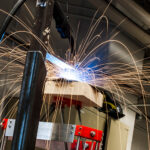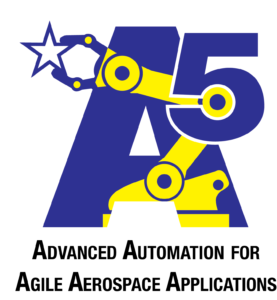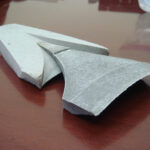
Advanced Automation for Agile Aerospace Applications (A5)
 The need for automation within manufacturing is increasing to help drive productivity, improve the well-being and safety of the workforce, and perform precision processes that may be difficult to achieve using manual methods. Traditionally, the robotics industry has been driven by the automotive market where production volume is very high. This market can absorb the costs associated with the time it takes an expert to program the robot and use many stationary robots to perform single operations. However, within the Aerospace industry, production volumes are much smaller making it difficult to absorb these costs. Traditional automation solutions for aerospace manufacturing tend to be purpose-built machines, often dedicated to a specific aircraft or component. These machines demand large initial capital outlays and significant operating expenses, requiring expert programmers to manage not only the initial machine programming, but also ongoing program maintenance to accommodate production variability.
The need for automation within manufacturing is increasing to help drive productivity, improve the well-being and safety of the workforce, and perform precision processes that may be difficult to achieve using manual methods. Traditionally, the robotics industry has been driven by the automotive market where production volume is very high. This market can absorb the costs associated with the time it takes an expert to program the robot and use many stationary robots to perform single operations. However, within the Aerospace industry, production volumes are much smaller making it difficult to absorb these costs. Traditional automation solutions for aerospace manufacturing tend to be purpose-built machines, often dedicated to a specific aircraft or component. These machines demand large initial capital outlays and significant operating expenses, requiring expert programmers to manage not only the initial machine programming, but also ongoing program maintenance to accommodate production variability.
The National Center for Defense Manufacturing and Machining (NCDMM), Southwest Research Institute (SwRI), and the Boeing Company teamed to develop technology funded by the Air Force Research Laboratory (AFRL) to advance the state of the art in robotics for the Aerospace Industry. This Advanced Automation for Agile Aerospace Applications (A5) program investigated developing, demonstrating, and transitioning a framework for Smart Automation that permits production flexibility and the ability to adapt to the demands of aerospace manufacturing and maintenance, typically characterized by high value components, dynamic environments, and variable part mixes.
Under this initiative, the team developed a large 23,000-lb mobile, adaptive, robotic sanding solution that was capable of sanding 60% of the surface area of a C-17 aircraft to replace manual sanding operations. The design included a mobile omni-directional base with a large inclined rail allowing for 7-axis of motion. The mobility of the system allowed the robot to approach the work as opposed to being stationary. On the rail was a 4-m reach Yaskawa robotic arm with a 3-disc sanding end effector. The end of arm tooling included a dust extraction system to minimize operator exposure to harmful particulates and a vision-based sensing system to control the sanding process to a certain depth (i.e. able to sand to primer but stop before the substrate). A 3D sensing system to scan the surface and automated path planning based on sensed surface with constraints was incorporated into the overall functionality of the system, along with a natural user interface for the operator commanding the work region. This eliminated the need for any type of expert programming to occur as the system self-programmed itself to perform the work.
The team successfully demonstrated the technology on a full-scale C-17 demonstration at Robins Air Force Base (AFB), Georgia in October of 2018 and is now transitioning the system to have the ability to perform Non-Destructive Inspection (NDI) on F-15 aircraft showcasing the overall versatility of the A5.


